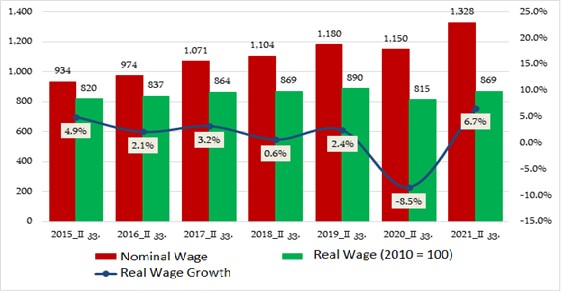Natia Turnava: “The average labour remuneration has increased by 15% and more. This is very important and in principle – inevitable when an economy recovers.”
Verdict: FactCheck concludes that Natia Turnava’s statement is a MANIPULATION.
Resume:
The Minister of Economy and Sustainable Development analyses the dynamic based on the growth in nominal wages. However, an assessment of the trend based on a nominal wage analysis is manipulative. Therefore, a discussion based on real wages [1] which already include the reduced purchasing power effect caused by changes in price levels would be more relevant.
In the second quarter of 2021, the average wage is GEL 1,328 which is GEL 178 (15.4%) and GEL 148 (12.5%) more as compared to 2020 and 2019’s figures, respectively. However, of note is that in the same period, the consumer price growth rate is also quite high. In particular, in April-June (second quarter) of 2019, the inflation rate was 6.5% and it was 8.3% in the same period of 2020. Given these circumstances, the average monthly real wage in the second quarter of 2021 is basically at par with 2018’s figure and 2.4% less as compared to same figure of 2019. As compared to the second quarter periods of the past years, the real wage in the second quarter of 2021 is higher (by 6.7%) only vis-à-vis the same period of 2020.
Analysis:
The Minister of Economy and Sustainable Development of Georgia, Natia Turnava, offered her commentary on the statistics of average wages and stated: “The average labour remuneration has increased by 15% and more. This is very important and in principle – inevitable when an economy recovers.”
On 15 September 2020, the National Statistics Office of Georgia published updated data on average wages. According to the document, the average nominal wage in the second quarter of 2020 was GEL 1,328 [2] which is 15.5% more as compared to the same period of 2020. Natia Turnava spoke about the growth of the nominal average wage within the context of “economic recovery” as something natural. However, she did not mention money’s purchasing power effect and claiming whether or not wages have really increased for employees without taking this into account is not really possible in a discussion on remuneration growth.
When a wage or any another type of income changes, an individual is not interested in how much money he will earn but what he will be able to purchase with that wage amount. Therefore, two key indicators have to be taken into account simultaneously when speaking about income changes:
1. How a person’s nominal income has changed.
2. How the consumer price index/inflation has changed in the country.
An assessment of a trend based on a single factor, such as nominal wage, is manipulative. Therefore, a discussion based on real wages [3] which already include the reduced purchasing power effect caused by changes in price level would be more relevant.
In order to assess the trend of wage income changes across the entire economy, the average wage of hired employees is used as an indicator of income changes and the consumer prices index is used as an indicator of price level changes. The National Statistics Office of Georgia processes and published this data. Graph 1 illustrates the figures calculated on the basis of this data.
Graph 1: Changes of Average Monthly Wages of Hired Employees

Source: National Statistics Office of Georgia
As illustrated by the graph, the nominal wage in the second quarter of 2021 is GEL 1,328 which is GEL 178 (15.4%) and GEL 148 (12.5%) more as compared to 2020 and 2019’s figures, respectively. However, of note is that the consumer price growth rate is also quite high in the same period. In particular, in April-June (second quarter) of 2019, the inflation rate was 6.5% and it was 8.3% in the same period of 2020. Given these circumstances, the average monthly real wages in the second quarter of 2021 is basically at par with 2018’s figure and 2.4% less as compared to the same figure of 2019. As compared to the second quarter periods of the past years, the real wages in the second quarter of 2021 is higher (by 6.7%) only vis-à-vis the same period of 2020.
[1] Real wages are wages adjusted to changes in consumer prices (inflation).
[2] Gross salary which includes income tax.
[3] Real wages are wages adjusted to changes in consumer prices (inflation).








